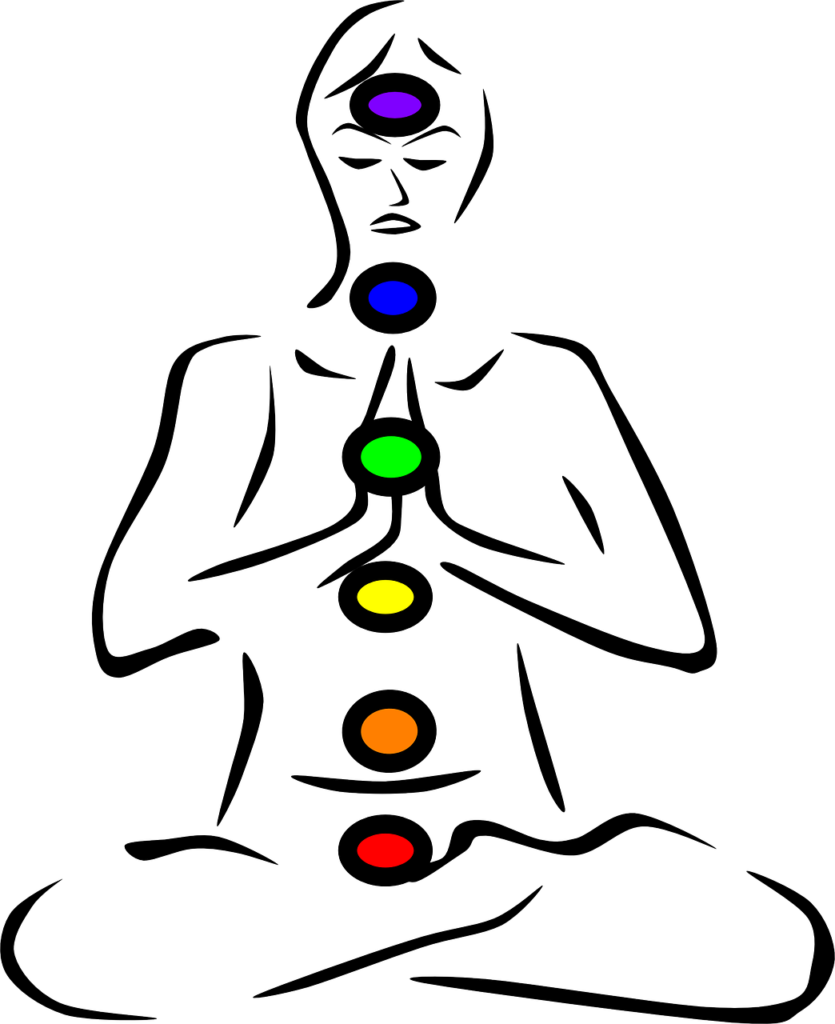The Human Body in Eastern Medicine

Eastern philosophy and medicine, originating in ancient India and China, have traditionally regarded body structures and the life processes occurring within as inseparable. Their terminology resides halfway between structure and function and identifies certain entities in the human body, representing the flow of life energy and, in some sense, conduits for that flow that do not correspond to anatomical structures recognised by Western medicine.
The Chakras
The chakras are the energy centres in a person’s body and are responsible for his or her physiological and psychological condition, as well as certain groups of organs. All vital functions of the human body are determined by energy that spins in the chakras. These can be defined as “whirlpools,” and in Indian, they are considered ”energy bursts” or “wheels.” The process of energy transformation happens in these centres.
Vital energy, along with blood, circulates around the meridians in the chakras and fuels all organs and systems in the human body. When the circulation in these meridians stagnates, the human body becomes susceptible to various disorders. An excellent preventative method, designed explicitly to battle such stagnation is Qi Gong, an ancient Chinese method for self-healing which activates the energy centres. Qi Gong teaches people to release the energy themselves by massaging specific areas corresponding to the different chakras.
There are 49 chakras mentioned in the Vedic Canons, seven of which are basic; 21 are in the second circle, and 21 in the third circle.
Energy Channels
According to the Vedis, there are multiple energy channels leading to different locations from the chakras. Three of these channels are basic. The first one, called “shushumna,” is hollow and is concentrated in the spine. The other two energy pathways, “ida” and “pingala”, are located on either side of the spine. These two channels are the most active in most people, while “shushumna” remains stagnant.
The Seven Basic Chakras
The seven basic chakras spin at high speeds in the body of healthy individuals but slowdown in times of sickness or with advancing age. When the body is in a harmonious balance, the chakras are partially open. Closed chakras are unable to receive energy, leading to various disorders. A brief description of the seven chakras follows:
Muladhara
The first basic chakra, “Muladhara,” is located at the base of the spine in the tailbone area. Life energy, which is at the core of a strong and healthy immune system, is stored in this chakra. It is impossible for a person to become sick, old or even to die, before exhausting his or her reserves of this vital energy. The very will for life is controlled by Muladhara. It is also in charge of the bones and joints, the teeth, the nails, the urinogenital system and the large intestine.
The first symptoms of a malfunctioning Muladhara are unreasonable fear, faintness, lack of security or faith in the future, leg and foot problems, and intestinal disorders. The interrupted activity of the Muladhara chakra causes lack of energy, digestive problems, diseases of the bones and spine, and nervous tension among others.
Svadhistana
The second chakra, “Svadhistana,” is located at the level of the sacrum, three or four fingers below the belly button. This chakra regulates the pelvis, the kidneys and sexual functions. We also feel other peoples’ emotions through this chakra. Symptoms of a malfunctioning “Svadhistana” are kidney problems, cystitis and arthritis.
Manipura
The third chakra, “Manipura,” is found in the solar plexus area. This chakra is the centre for storing and distributing energy produced by digestion and breathing. It is responsible for vision, the gastrointestinal system, the liver, the gall bladder, the pancreas and nervous system. Symptoms of a stagnant “Manipura” include increased and constant worrying, as well as stomach, liver and nervous disorders.
Anahata
The fourth chakra, “Anahata,” also called the heart chakra, is located in the chest area. We generate and receive love through this chakra. It is in charge of the heart, the lungs, the bronchi, the hands and the arms. Symptoms of stagnation include depression and cardiovascular imbalances.
Vishudha
The fifth chakra, “Vishudha,” is located at the throat level and is the centre of analytical skills and logic. This chakra sustains the skin, hearing organs, along with the trachea and lungs. Symptoms of stagnation include a lack of emotional stability, discomfort in the cervical spine, sore throats, difficulties communicating, and oesophagus and thyroid ailments.
Adjna
The sixth chakra, “Adjna,” is located between the eyebrows and is called the “third eye.” This is the throne for the human brain. “Adjna” circulates energy to the head and pituitary gland and is also responsible for determining our harmonious development. If a person’s “third eye” ceases to function properly, one might notice a decrease in intellectual ability, headaches and migraines, earaches, olfactory illnesses, and psychological disorders.
Sahasrara
The seventh chakra, “Sahasrara,” is found at the very top of the head and represents the apex where an individual’s energy vibrates with the highest frequency. It is considered a spiritual centre and the entrance to the body for cosmic energy. A stagnant “Sahasrara” can result in a decrease in, or lack of, inner wisdom, as well as a lack of basic intuition.
With this basic knowledge of the first seven chakras, we can address the question:
“How do we use this information to locate the causes of our troubles and problems, and with the help of Eastern Medicine, learn to control the functions of the chakras ourselves?”
From the perspective of Eastern Medicine, our health depends on the distribution of our energy-consciousness informational field. A shortage of energy inevitably causes ailments.
According to Tibetan Medicine, the only difference between youth and old age, and between a sick and healthy individual, is the difference in the rotating speed of the whirlpool energy centres of the chakras. If these different speeds are balanced, old people will rejuvenate and sick people will heal.
Therefore, the best way to preserve and keep our health, youth and vitality is to restore and maintain a balanced movement of the energy centres. The easiest way to keep the chakras balanced is through a set of physical exercises, which are in fact not simply exercises, but rituals. These rituals allow the human body to mould its energy centres to an ideal level of function.
The Seven Rituals
The seven rituals, one for each chakra, must be performed together every morning and when not possible, in the evening. Skipping rituals unbalances energy distribution, and so for the best results, no more than one day per week should be missed. The daily chakra rituals are necessary not only for revitalizing the body, but also for achieving success in every facet of life.
“Once you learn how to transform your energy, you will also become happier.”
Meditation
Another method of keeping the chakras balanced and in their optimal half-open state is meditation. Meditative methods are universal to the human experience; they have accumulated over the ages through many different cultures and have proven their value in attaining peace, clarity, equanimity and in transcending despair. People who meditate on a regular basis are usually calmer, more secure, more joyful and more productive human beings. They are more effective in their everyday lives because they use their mental and physical potential, abilities and skills to their fullest extent.
All too often, we humans fail to realise the great latent powers which are, as yet, unawakened in our bodies. We must learn how to revive and utilize them. This can only be achieved through meditation. Eastern men of wisdom, who believed meditation to be a vital necessity, stumbled on this discovery thousands of years ago. They learned to influence their inner organs and control their metabolism with the power of their minds.
Meditation is to the mind what exercise is to the body; mental strength can be built up just like physical strength. Just as in athletics, it is important for an individual to train his or her body, it is important for an individual to train his or her mind through meditation.
The best time for meditation is early morning, preferably at dawn. Do not meditate when you are sad, aggravated, desperate or sick, because these intense emotional and physiological distractions make an enlightened state of mind impossible.
For an effective meditation session, it is preferable to arrange for the undistracted silence of a quiet, clean room with flowers, or the soothing sounds of Mother Nature – near a lake, river, waterfall, woods or fields. Many different mental practices, having their origin in historical traditions, fall under the general heading of “meditation.”
These paths of mental development can involve emotional and intellectual facets and may also be coordinated with specific movements. Meditation can be structured or unstructured. The process of meditation is nothing more than quietly going within and discovering that higher component of yourself.
Learning to meditate is learning how to live rather than talking about it…”
